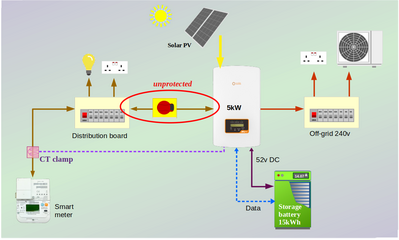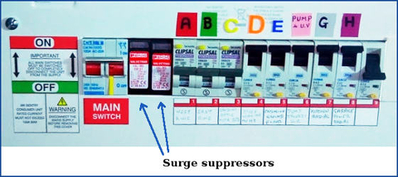Isolating the system for a planned power cut
@batpred - that Solis installation page is too vague.
Yes, they state that there's RCD protection inbuilt to the inverter.
But we don't know to what extent that offers protection to the inverter itself,
nor whether that protection covers appliances which are connected to the always-on port.
As matters stand, that integral RCD would still leave the supply cable and isolation switch unprotected.
I don't like having any conductors leaving the distribution board without both over-current and earth-leakage protection.
The regulations for new installations are even tighter.
You now need ARC-detection trips within the consumer unit.
Those will disconnect the circuit in the event of cable damage within the wall - perhaps vermin eating the insulation.
Whether that measure will reduce house-fires or not is too early to say, but insurers like it.
Save energy... recycle electrons!
I will continue the discussion on the solis installation on the Fogstar battery thread
16kWh Seplos Fogstar battery; 8kW Solis S6-EH1P8K-L-PLUS hybrid inverter; Ohme Home Pro EV charger; 100Amp head, HA lab on mini PC
Bu the way, my understanding is that arcing detection is not required for new circuits unless it is a shared use property? Or is it only for rental properties?
As for SPD protection, for the extra £20 or so when getting a new unit, it was a no brainer. It also helped us removing the ad-hoc surge protectors we had like to stop the boiler PCB blowing up when power comes back following a black-out.
16kWh Seplos Fogstar battery; 8kW Solis S6-EH1P8K-L-PLUS hybrid inverter; Ohme Home Pro EV charger; 100Amp head, HA lab on mini PC
Posted by: @batpredmy understanding is that arcing detection is not required for new circuits unless it is a shared use property?
That's correct.
I was mentioning it as something which would be a future requirement.
Both arc-detection and surge suppression devices (SPD) are like paying an insurance package.
Even if you decide not to implement them, you should at least know that they are available options and why.
There are also different levels of protection offered, according to the specification of the devices you choose to install.
Your SPD might do all that you want at £20.
On the other hand, I use high-end Phoenix Contact suppression systems on both mains and PV panel connections.
The pair in the consumer unit which receives the mains incomer cost substantially more than £100.
There are reasons why some insurance premiums cost less than others.
Save energy... recycle electrons!
Insurance helps and when adding high powered devices like EV chargers, PV panels and some inverters and heatpumps, the other circuits may need to be a bit more shielded, and future proofing is also worth. We had our supply upgraded to 100A but only after a few years and another visit did I feel they had given us that insurance.
Price of components can also be driven by volume and other considerations like supply chain requirements to recoup r&d costs.
16kWh Seplos Fogstar battery; 8kW Solis S6-EH1P8K-L-PLUS hybrid inverter; Ohme Home Pro EV charger; 100Amp head, HA lab on mini PC
Apologies, I don't follow what you've written @batpred
The possibility of damage from surges doesn't increase with 'high powered' devices.
In fact the device most likely to be damaged by a surge or spike on the mains is a landline telephone or internet router, supplied by copper wires.
That's because there can be a voltage difference between the mains and the telecom cables.
Posted by: @batpredWe had our supply upgraded to 100A but only after a few years and another visit did I feel they had given us that insurance.
I was referring to 'insurance' as a metaphor.
The size of the service fuse doesn't change the susceptibility to damage from surges.
Posted by: @batpredPrice of components can also be driven by volume and other considerations like supply chain requirements to recoup r&d costs
Phoenix Contact surge arresters dominate the commercial market.
There are thousands of types in their catalogues.
They are proven to be affective because Pheonix Contact are based in the Black Forest, in the south of Germany.
That area has the highest number of lightning storms in Europe.
They can easily test products in real-world conditions as well as a laboratory.
It's relatively easy to make a surge arrester which protects equipment from a single spike.
The key point is what then happens to the arrester?
If it doesn't recover to full operational specification, then it's useless.
The next surge will get through.
Buyers are prepared to pay more for an anti-surge device that is more likely to provide protection.
Save energy... recycle electrons!
I may have lost you there.. I use the insurance term as proxy for the "additional life" that was only given when the DNO replaced some components that despite being rated for 100A, were more fitting as museum pieces!
When I broadly mentioned circuits needing to be "shielded", it was not in the electrical sense, a better word may have been "cushioned". Specifically that when inverters and similar components are added to a household, some components that protect other circuits like RCDs type AC need replacing, ideally with RCBOs type A. We had a mid sized plastic consumer unit and that went a few months ago, as part of the prep.
16kWh Seplos Fogstar battery; 8kW Solis S6-EH1P8K-L-PLUS hybrid inverter; Ohme Home Pro EV charger; 100Amp head, HA lab on mini PC
- 26 Forums
- 2,356 Topics
- 53.4 K Posts
- 323 Online
- 6,017 Members
Join Us!
Worth Watching
Latest Posts
-

RE: Controlling Daikin Altherma via P1P2 and Home Assistant
On the contrary, @toodles, that’s a lot of help. I’d ne...
By Majordennisbloodnok , 1 hour ago
-
RE: Octopus Cosy Heat Pump Owners & Discussion Thread
@kevh with the Cosy 6 I know it definitely goes to arou...
By HarrisonC , 14 hours ago
-
RE: Setback savings - fact or fiction?
@cathoderay yes I am familiar with SQL. Interesting num...
By RobS , 15 hours ago
-

Parsnip, Bacon & Coconut Milk Soup
First let me say, I am only a cook because I am human a...
By Toodles , 15 hours ago
-
RE: Electricity price predictions
Ben Watts posted on LinkedIn that he had updated this w...
By Judith , 20 hours ago
-

RE: The good, the bad and the not that great – my heat pump installation
Small update, Emailed and Spoke to Midea UK and they ...
By Burtis , 21 hours ago
-
RE: Solis S6-EH1P8K-L-PLUS – Why I Chose It and What I’ve Learned So Far
@bash Octopus does charge for the admin. The process al...
By Batpred , 21 hours ago
-
RE: External pipework insulation
@transparent HI all The products you mention are ver...
By David Smith , 21 hours ago
-
RE: New Fogstar 15.5kWh upright solution
Issues still under investigation by Solis... Fogstar ...
By Batpred , 21 hours ago
-
RE: Who's your electricity provider and what's your tariff?
I agree, the consumer is not being properly represented...
By Batpred , 21 hours ago
-
RE: Advice on internal circulation pump noise
Thanks @mikefl - I'll maybe have a look at the lock-shi...
By jtg , 2 days ago
-

RE: Heat Pump Heats the House… But It’s Not Cosy. Emitter Changes or System Tweak?
@toodles interesting suggestion, thanks. I will try to...
By GrahamF , 2 days ago
-
RE: Mitsubishi Ecodan Auto Adaption trial to stop cycling.
The interval you talk of, i think, will be 60min for an...
By F1p , 2 days ago
-
Agree with @majordennisbloodnok on the setbacks. We hav...
By ChandyKris , 3 days ago
-

RE: Speedcomfort radiator fans
@deltona the way the links were added broke the page. A...
By Mars , 3 days ago
-

RE: Refrigerant R32, is it now banned in the EU from 1st Jan 2027 for monobloc ASHPs?
This has been delayed from what I believe to be this ye...
By dgclimatecontrol , 3 days ago
-
RE: Are We Sleepwalking Into Another Race to the Bottom?
this is why I provided current flow temperatures in the...
By ksim , 3 days ago
-

RE: Why Millions of UK Homes Struggle With Heat Pumps
There's many homes that would be quite a disruption for...
By dgclimatecontrol , 3 days ago






